|
CHAPTER III
THE LAND OF MAN'S ADVENT ON EARTH
In the land of Mu we have unquestionably found where man made his
advent upon the earth. Various records conclusively prove that this
land was the Biblical Garden of Eden; prove that Mu lay to the west
of America and to the east of Asia, and therefore in the Pacific
Ocean.
Data that I have examined also show that the motherland was in the
Pacific Ocean, because much of this data consists of the actual
remains of the vanished continent. On parts that were not submerged
there still remain vestiges of temples, traditions, statuary and
sacred symbols, and the written evidence and inscriptions declare
that these mementoes of a vanished race originated in Mu.
The
authenticity of the remains is corroborated in every possible manner
- by written records, by inscriptions, by customs, by language, and,
finally, by traditions.
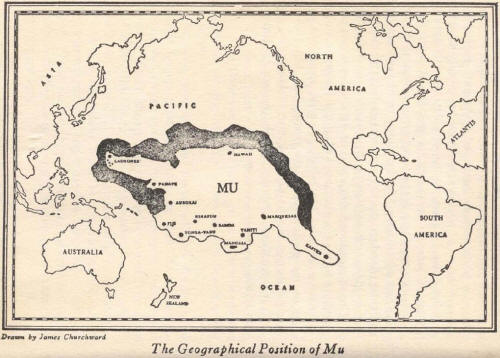
I have established by this indisputable evidence the place where
there was a prehistoric civilization.
Much of the evidence is
concretely furnished by stone temples, stone monuments, stone
statuary, cut and dressed stone waiting shipment, and the quarries
whence the stone came. In these quarries unfinished statuary has
been found, and as these discoveries have been made in the South Sea
Islands, it demonstrates beyond shadow of a doubt that those islands
were once parts of the submerged continent.
The records and data based on the supposed age of the Troano
Manuscript establish that the land of Mu was in existence up to the
very edge of historical times - existed, that is to say, up to
within 12,000 to 12,500 years ago. Taking the islands whereon
remains and traditions have been found, I have sketched a map
indicating where Mu was situated in the Pacific Ocean.
There is
nothing upon which to base either a western or a northern coast
line. From various records it would seem that this continent
consisted of three separate lands, divided from each other by narrow
seas or channels, but where or how these divisions were made by
nature there is nothing to show, except, possibly, an Egyptian
hieroglyphic which represents three long, narrow lands running east
to west
For various reasons, the principal one being colonization, I think
the land ran much farther north than has been shown.
I have given
Easter Island as the southeast corner, Tonga-tabu as about the
southwestern corner, the Ladrones as the northwestern corner, Hawaii
in the north, and no defined northeastern corner. I have made many
large bays and estuaries, because records show that the land was
low, without mountains. As the land was so low and rolling, with
immense plains, it would naturally have a coast line similar to the
one I have drawn.
Both the
Troano Manuscript and the Codex Cortesianus refer to the
land of Mu as the land of hills or "ridges of earth." The Greek
record speaks of "plains." I felt convinced that all three of the
records are correct, because up to the time the continent vanished
beneath the Pacific there were no mountains. The volcanic workings
which sent Mu beneath the waves were preparatory to mountain
raising.
Where we find specks of land above water, with incontrovertible
evidences of continental resources, we are made doubly certain that
these specks are parts or remains of a continent.
These bits of land
are, as I have said, little islands peopled by savages. They are
thousands of miles away from any mainland, and it is therefore the
strongest possible proof, stronger than any record, inscription or
tradition, that back in prehistoric times there was a continent and
that the continent was peopled by highly civilized human beings.
The ancient records and remains on the South Sea Islands show us
that man was created a civilized being but untutored and uncultured.
He was created with a knowledge of his own soul and believed in and
worshiped the Deity. It is revealed by the presence of certain
figures used as sacred symbols that man, generally, was at that time
in an undeveloped intellectual state and the simplicity of the first
sacred symbols was necessary in order to convey ordinary subjects to
his mind.
When, however, we first get in touch with man, thousands
upon thousands of years after his advent upon earth, we find that he
was then in a highly enlightened and civilized state - and that was
more than 50,000 years ago!
Certain archaeologists have, in their writings, touched the subject
of the land of Mu and the Lands of the West; but, as they took no
pains to verify various records that came before them, having simply
made deductions, it is time that readers interested in the early
appearance of man on earth should be informed of some positive facts
based upon my own careful investigations.
Schliemann, on apparently two records only, the Troano Manuscript
and the Lhasa Record, asserts that Atlantis was the land of Mu.
These records do not state that Mu and Atlantis were identical; it
is mere surmise on the part of Schliemann. Other records which he
might have consulted would have told him plainly that the land of Mu
lay to the west of America and not to the east, the location of
Atlantis.
However, both
Atlantis and the
land of Mu were destroyed
by volcanic eruptions and submerged. Science has proved that beyond
the shadow of a doubt.
Le Plongeon advanced the theory that Central America was the Lands
of the West and therefore the land of Mu, basing his deductions on
the contour of the land around the Caribbean Sea, but forgetting
entirely that all records establish the fact that the Lands of the
West were destroyed and submerged, while Central America to this day
is, of course, unsubmerged.
This is as plausible as saying that a
certain man is dead while he is arguing some point with you.
Possibly some of these errors arose from the fact that certain
records read in Europe were written in America, and the readers,
without thinking, based their calculations from Europe instead of
from America.
This would be in keeping with the reference to
Atlantis made by the old Greek philosopher:
"The Land beyond the Sea
- the Saturnian Continent."
The Saturnian Continent, by the way, was
one of the ancient names for Atlantis.
The exact difference between the records is - the Lands of the West
from America and the Land beyond the Sea from Europe. Evidently the
writer of the Greek record wished to avoid mistakes, because he
qualified his statement about the Land beyond the Sea by designating
it clearly as the Saturnian Continent, which was Atlantis.
Surely
this is plain enough to satisfy the most exacting !
The Troano Manuscript places the sinking of the land of Mu as having
occurred approximately 12,500 years ago. (I think 12,000 is nearer
correct.) However, the figures must all be approximate because the
exact age of the Troano Manuscript is not known.
Souchis, high priest of the temple of Sals, told Solon that Atlantis
sank 11,500 years ago and that the passageway to the Lands of the
West was blocked on account of the sinking of this great country,
and the destruction of the intervening country beyond Atlantis by
cataclysms, which made that country impassable.
This clearly
eliminates the possibility that Atlantis may have been the land of Mu or the Lands of the West.
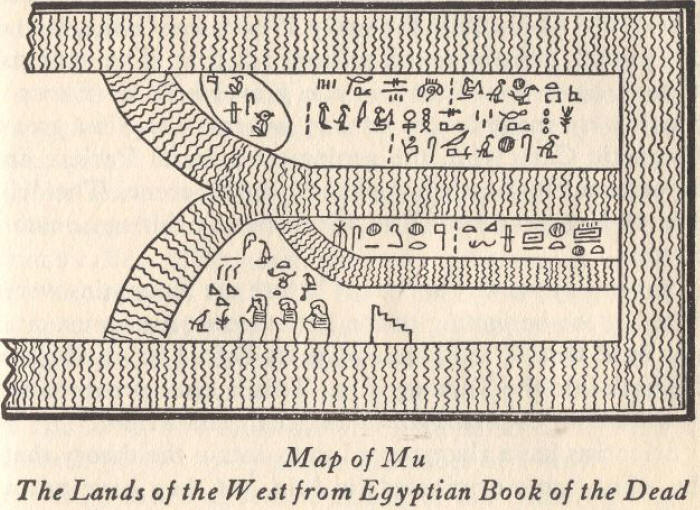
Those who have hitherto written about the land of Mu have ignored
the most important records connected with the prehistoric continent,
namely, the remains on the South Sea Islands and the inscriptions on
the walls of the Temple of Sacred Mysteries at Uxmal, Yucatan, to
which may be added the astounding traditions found among the South
Sea Islanders.
From the remains found on the South Sea Islands supported by records
and traditions, it is shown that the South Sea Islanders, in spite
of their present savage and semi-savage state, were not always in
that condition; it is clearly established that they are the
descendants of highly civilized and enlightened forefathers. Looking
at their present condition, it is self-evident that far back, in the
prehistoric past, some great calamity overtook their ancestors.
In their anxiety to sustain their monkey theories, scientists have
tried to prove that man did not appear upon the face of the earth
until the early Pleistocene Time, but a pin-prick can dissipate this
scientific bubble.
The remains of man have been found in the gravel
beds of Europe which were made by the settling waters of the last
great Magnetic Cataclysm, the geological Glacial Period, an
occurrence that marked the end of the Pliocene. The den men of
Nebraska were also wiped out by this same cataclysm.
Niven's upper city was built before the mountains were raised at the
beginning of the Pleistocene; his lowest city was built tens of
thousands of years before this and goes far back into the Tertiary
Era. This is also corroborated by the cut on Capital Hill in Smyrna,
Asia Minor.
Scientists have always tried to maintain the theory that the white
races originated in Asia, yet they have not a vestige of proof to
sustain it - not a single record of any description. Their
deductions are only surmises. I will undertake to show in this book
where they originated and trace them to Europe.
One of the most startling discoveries is that the natives of the
Polynesian groups of South Sea Islands are a white race. Further,
they are an exceedingly handsome people, a link that joins perfectly
the white races of the earth.
As I have established, records show us that man undoubtedly made his
advent on this earth in the land of Mu, and the Polynesian Islands
are jagged remains of the ill-fated continent. Records also show
that Mexico and Central America were colonized and settled by people
from the land of Mu.
Traditions support the fact that these first
colonizers from Mu were blond-whites, that these blond-white people
were driven from the land by another white race of more swarthy
complexion - brunettes:
that the blond-white people sailed in their
ships to a far-off land in the direction of the rising sun - east -
and there settled, in the northern part of Europe - Scandinavia of
today.
It is also made plain by these same records that southern
Europe, Asia Minor, and northern Africa were colonized and settled
by the brunette race by-way of Mayax, Central America and Atlantis.
If we leave the white Polynesians and visit one of the brown races
found farther west, in the group of South Sea Islands called
Micronesia, we find the brown, as well as the white races of the
South Sea Islands, are today splendid specimens of physical manhood.
They resemble the finest of the old Greek bronze statues. The
Fijians, a brown race, are said to be the most skilled of the South
Sea Islanders. The third picture in the series of halftones (between
pages 160-1) shows a member of a brown race, Arawali, a native of
Arorai Island of the Gilbert group, which lies about 4000 miles
southwest of Hawaii.
The picture shows a girl with a beautifully shaped, well-developed
head, of pleasing countenance and gentle expression.
She is the
daughter of the King of Arorai Island. It has been said of her that,
"she is a very gentle, lovable woman, but quick-tempered and
slightly jealous, but very dignified notwithstanding her wretched
surroundings."
Arawali's head and face belong to the representative of a high type
of civilization, although her dress is that of a savage. Poor
Arawali! She is one of a tribe of cannibals, but, strangely enough,
she herself has never tasted "long-pig" the euphemistic name applied
by the natives to human flesh.
In her hand she carries a fan, the
ornamentation of which is the royal escutcheon of Mu - the Empire of
the Sun.
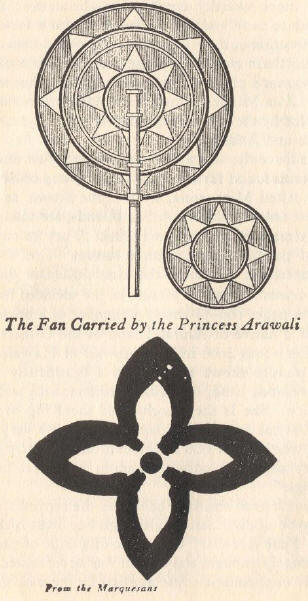
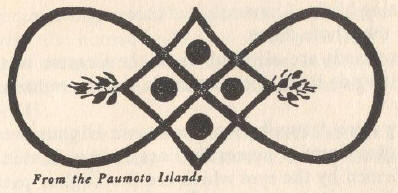
No ancient record has ever been found that mentions savagery as
existing on any spot of the earth's surface prior to the destruction
of Mu.
Then why did such magnificent specimens of man as the
forefathers of the South Sea Islanders become degraded cannibals?
Our story of the great calamity that overtook the first race of man
answers this question.
Bird Symbols of The Creator. Birds as symbols of the Creative
Attribute of the Deity appear to have been the most prominent symbol
for the Creative Forces among the people who inhabited the
northeastern parts of the Motherland. The Bird Symbol extended south
as far as where Hawaii now stands and perhaps farther.
Without question it was held as a sacred symbol among all people of
the Motherland, although among some not the favored creative symbol.
There are many records about sacred birds in all Oriental countries,
in Egypt, Babylonia and ancient Mexico, as shown by Niven's Mexican
Stone Tablets: and, today, it is much alive among the North American
Indians who call it the Thunder Bird.
The Indian legend says that
"lightning is the blinking of the Thunder Bird's eyes, and thunder
is the flapping of its wings: also, that rain comes from a lake
situated in the middle of the back of the Thunder Bird.
Niven's Mexican Bird Tablets. Among Niven's collection of 2600
ancient stone tablets, there are about thirty containing birds. I
have selected three as being representative of the whole thirty.
These birds are all symbols of the Creator as told by the writing on
them, the old temple esoteric numeral writing.
They were drawn by some unknown Uighur people, as the Uighur form of
numerals, lines or bars, is used. This is confirmed by the eyes
which are the Uighur pattern of the Picture of the Sun and the
monotheistic symbol of the Deity.
The central figure, No. 1086, is holding the hieratic letter H. The
alphabetical symbol for the Creative Forces.
In Hawaii there is a legend that,
"a big bird from on high came down
and laid an egg in the sea. The egg burst and Hawaii came forth."
So that from this we may infer that the Bird Symbol for the Creator
was used by the ancient Hawaiians.
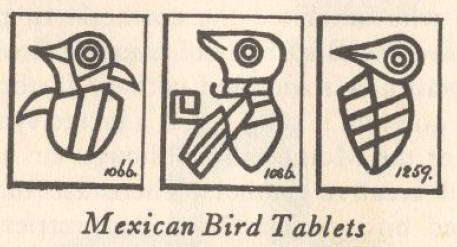
Seb, the Egyptian Bird. Among the Egyptian Pantheon we find one of
the gods named after a bird, a goose. The goose is the sacred bird
mentioned in Oriental legends. Upper Egypt was colonized from India.
Seb was called "the father of the gods," "the bearer of the gods,"
etc. Seb is the Egyptian name for a certain species of goose which
was worn as a symbol on his headdress.
Seb was also called "the
great Cackler" which produced the mundane egg out of which the earth
was produced; therefore, the human body also.
It is written,
"I
protect the egg of the great Cackler. If I thrive it thrives, if I
live it lives, if I breathe the breath of air it breathes".
(Book of
the Dead)
It here also clearly shows that the bird Seb was a symbol of the
Creative Forces - the Great Primary Four.
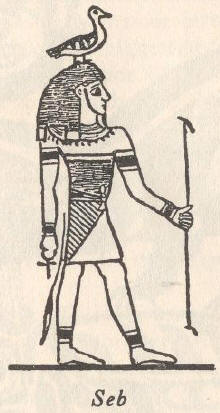
A North American Indian Tableau Depicting the Destruction of Mu.
This tableau comes from the Nootka Indians who live on the west
coast of Vancouver Island, British Columbia, Canada.
While there are scores, yes, hundreds of writings, telling of Mu and
her destruction, and various compound symbols forming vignettes in
the ancient Maya writings, such as the Troano Manuscript, the
Borgian Codex, the Codex Cortesianus, throughout the world I have
only found two tableaux or pictures showing the manner of her
destruction. First, the Egyptian and now this North American Indian.
There is, however, a marked difference in the two.
The Egyptian
depicts Mu falling into an abyss of fire, the North American Indian
tells of the waters flowing in over her and submerging her - two
phases of the general description of her destruction - so that both
the Egyptian and the North American Indian are shown to be correct.
Although these two peoples are so widely separated on the earth's
surface now, at that time both knew the scientific cause of Mu's
destruction.
Many of the symbols forming this Indian tableau are identical with
those used in Mu, while others are not so familiar.
The most prominent change from the general writings of Mu is in the
symbol used by the Indians for symbolizing the waters. In the Naga,
Uighur, Karian, American Maya, etc., an unadorned serpent was used,
called Khanab, its body generally shown in wavy lines like the rolls
of the ocean swell.
These old Indians, however, have gone their
Southern neighbors one better - they have divided the waters, using
the biggest of fishes to symbolize oceans and the wavy serpent line
to symbolize lesser waters. They call their symbol for the oceans
the killer whale. This symbol is found among many of the Northwest
Indian tribes if not all; therefore, it had a common origin among
them.
It was probably designated "the killer" on account of its
having swept over and drowne'd so many millions of the people of Mu.
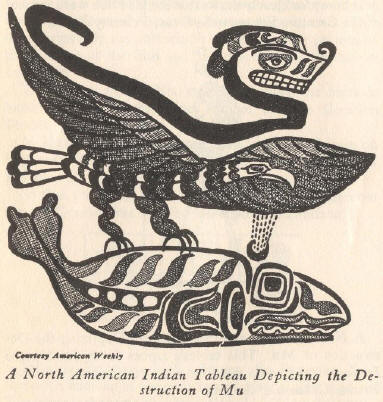
The tableau is divided into three figures - a serpent, a bird and a
fish.
Top: The Serpent. This serpent has a plume of feathers on its head ;
it is, therefore, an adorned serpent. It is a conventional drawing
of Quetzacoatl, the feathered serpent of the northern people of the
Motherland. An adorned serpent has always been the symbol among all
ancient peoples for the Deity as the Creator and His Creations - the
Seven Commands as given in the Books of the Golden Age.
In the center of the picture is a conventional bird which the
Indians call the Thunder Bird - Thunder Bird legends permeate the
legends of Indians of the Northwest.
In Mu I find birds were used in the northern parts to symbolize the
Sacred Four - the Four Great Primary and Creative Forces - the
executors of the Creator's seven great commands.
The use of these
bird symbols must have been quite extensive in the Motherland as we
find their reflection in Hawaii, Pacific Ocean; Niven's tablets,
Mexico; the Egyptian god Seb - and also throughout the Orient. In
addition to birds crosses were used to symbolize the Sacred Four.
Judging by what has come to light, crosses were universally used. As
far back as 70,000 years ago the plain cross appears in the Sacred
Writings as the symbol of the Four Creative Forces.
Bottom: Third figure - is a large fish, a conventional whale, the
Killer Whale. The North American Indians are the only people I have
found who use a fish to symbolize water, and yet it is a most
natural symbol. The wonder to me is that it did not become prominent
among all people.
The Thunder Bird symbolizing the Great Forces is depicted as
standing on the whale, which is the ocean waters, with its claws
embedded in the whale's back, showing that the waters are in the
grip and under control of the forces.
The whale, the ocean waters, is dead - quiescent, as its neck has
been broken by the forces; therefore, it can kill no more. The
tragedy has been accomplished.
This is shown by Magnetic Forces falling from the wings of the
Thunder Bird and forming an abyss.

No. 1. The eye of the whale is formed by two squares one within the
other, and a third solid square forming the pupil. The two line
squares symbolize mother and land, i. e., Motherland. The solid
black square, the pupil, symbolizes darkness, no sun shines upon
her. This in combination with the broken neck and the abyss, being
carried into it, reads: The Motherland has been carried down into
the abyss of darkness.
In Niven's Mexican tablet No. 1430 an exact counterpart of this eye
is seen.
From now on the reading is easy. I have only to deal with the
symbols in common use in the Motherland and most of her colonies.
No. 2. Through the mouth of the whale water is shown as carrying
down something to the throat.
No. 3. At the end of the mouth is a throat with the passage showing
near the Center. Beyond the throat is the Symbol (No. 4.), the
hieratic letter U of the Motherland's alphabet. The esoteric meaning
of this letter is an abyss. We now see that the Motherland was
carried down into a watery abyss - submerged.
No. 5. Directly beyond the abyss come four bars, one of the
Motherland's forms of writing numerals. Thus four bars meant the
numeral four. Four was the numeral symbol of the Sacred Four - the
Four Great Creative Forces.
No. 6. On the backbone of the fish are four disks, another popular
form of writing the numeral four.
No. 7. Above the backbone are shown five bars - the numeral five -
the symbol of the full Godhead of five, The Creator and his Four
Great Creative Forces.
This tableau asserts that the Motherland was destroyed indirectly,
through the Four Great Forces - a fact mentioned in all writings
about the destruction of Mu.
Legend. The Creator desired the destruction of the Motherland of
Man. The Four Great Forces, the executors of the Creator's commands,
caused the lands to go down and the waters to cover them over - They
went down into a watery abyss and were submerged.
In addition to the writings on the Nevada stones about Mu we have
here a purely American account of her destruction. Truly our western
America has more records of the very ancient past than all the rest
of the world put together. These American records are hoary with
age.
An Alaskan Totem Pole (halftones between pages 160-1). - This totem
pole comes from the Haidan Indians of Queen Charlotte Islands,
Alaska. The tribe is known as Kwa Ma Kolas. One of the old chiefs
explained the symbols on this pole as follows:
"The winged creature that crowns the pole is the Thunder Bird, the
representative of the Creator. 1 Lightning is the winking of the
Thunder Bird's sharp eyes, and thunder is the flapping of its wings.
Rain is the spilling of water from a huge lake in the middle of his
immense back. 2 The talons of the Thunder Bird are fastened in the
tail of the Killer Whale." 3
The Haidan Chief, the oldest living member of the tribe explained:
"In the days of the great flood, the Steel-headed man
3a was the
leader of all men and much beloved by the Thunder Bird, the Thunder
God and all the other gods.
"When this great flood swept over the face of the earth the gods
feared for the life of the Steel-headed man, whom they miraculously
changed into a steel-headed salmon." 4
1 The Thunder Bird is here shown as the symbol of the Four Great
Creative Forces, emanating from the Creator. I find this symbol with
the same meaning among many of the North American Indian tribes,
especially those of the Northwest.
Birds as symbols for the Four Creative Forces are found on many of
Niven's Mexican Tablets. It also appears with the Egyptians in their
ancient god Seb. The Thunder Bird appears in the oldest of the
legendary lore of the North American Indians. This, with Mexico and
Egypt, shows it to be of common origin, and that origin Mu.
2 Lightning is caused by the workings of the Four Great Primary
Forces and here described as their work. Not bad for the Redskin.
3 The Killer Whale. This symbol forms the greater part of the height
of the pole. The Killer Whale was the North American Indians' symbol
for the ocean. Most of the ten tribes of Mu used an unadorned
serpent for the symbol of the waters - all waters including oceans.
3a The Steel-headed man. About halfway up the pole is the figure of
a man - the Steel-headed man and the legendary founder of the Haidan
Tribe. In his hand he holds a lance with which he is piercing the
body of the Killer Whale.
4 Here we have the completion of a myth which has crept into the
original legend - Steel and Steel-headed salmon were names unknown
to those Indians 200 years ago. Without question, as there was a
stretch of water between Alaska and Mu, the forefathers of the
Haidans came by boat - they did not swim. There are many symbolical
carvings in the Orient depicting the Children of Mu leaving the
Motherland as fish skipping along the surface of the water. See Cut,
Page 186.
Nor does the legend show the arrival of women. How could the tribe
grow without women?
The Flood. Here a flood is recorded but sufficient data are not
given to lay whether it was the Last Magnetic Cataclysm or a
Volcanic Cataclysm caused by the sinking of Mu, or through the
formation of the gai belts in this region.
A flood is recorded by
many of the North American Tribes.
"During the days of the flood the transformed leader of men, lived
in the waters of the Nimpkish River. He gathered the posts and the
timbers for his dwelling but found he lacked strength to do the
building. 5
"Then the Thunder Bird appeared before the Steel-headed man in a
great crashing and rumbling of thunder. The Thunder Bird lifted his
god mask and revealed a human face to the Steel-headed man. 'I am as
human as you,' said the bird, 'and I will put up the timbers for
you. Here shall I stay with you to set up your tribe and be your
protector for ever.' Then with four claps of thunder, the bird
caused to appear a group of warriors who sprang out of the crashing
din full-armored. They with the Steel-headed man were the nucleus
from which the Haidan people grew." 6
5 Here there is an apparent omission in the legend. It is not shown
how the Steel-headed man became a man again.
6 In this sentence there is much that is mythical. No doubt the fact
is the group of warriors referred to were subsequent arrivals from
Mu.
The other symbols on this totem pole tell the story of the "Warrior
Princess," a double-headed monster of the sea, and the legend of the
Whale and Sea Lion.
The Whale and Sea Lion. "The Sea Lion was helping a warrior to save
his wife from the Killer Whale (drowning) when he was overcome and
struck down himself by the Killer Whale. He was saved and restored
to his family by Kolus, the protecting god of the household. The Sea
Lion was made a member of the tribe and married the Warrior
Princess, the daughter of the Steel-headed man. 7
7 The Sea Lion was without question a man of another tribe whose
totem was a sea HOD. In ancient times it was quite common to call a
man by the name of his totem.
Note
The Algonkin Indians have a tradition as told by John Ballou
in his Oahspe about the Flood and the submersion of Mu - called Pan.
As related in this book the tradition is actually two traditions in
one.
"The Algonkin Indians had a warning of the Flood and were building
ships in which to escape. 138 ships of the deluge set out from the
Continent of Pan (PAN)." Attached to and directly following this is:
"In the same day the gates of heaven and Earth were opened."
"And the earth rocked to and fro, as a ship at sea, and the rains
fell in torrents, and loud thunderings (earthquakes) came up from
beneath the floor of the world. And the vortex of the earth closed
in from the extreme, and lo, the earth was broken I A mighty
Continent was cut loose from its fastenings, and the fires of the
earth came forth in flames and clouds with loud roarings. And the
land rocked to and fro like a ship at sea. And again the vortex of
the earth is about on all sides, and by the pressure the land sank
down beneath the waters, to rise no more."
As the Steel-headed man governed all men, without a particle of
doubt he was their symbol for Mu. Mu governed the whole world and
was called - the Great Ruler.
Codex Cortesianus and Mexican Tablet,
page 79.
Back to Contents
|







